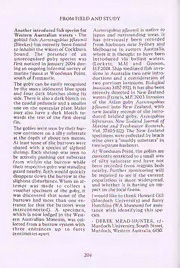
From Field and Study: Another introduced fish species (Acentrogobius pflaumii Bleeker) for Western Australian waters PDF
Preview From Field and Study: Another introduced fish species (Acentrogobius pflaumii Bleeker) for Western Australian waters
FROM FIELD AND STUDY Another introduced fish species for Acentrogobius pflaumii is native to Western Australian waters - The Japan and surrounding areas. It gobiid fish Acentrogobius pflaumii has previously been recorded (Bleeker) has recently been found from harbours near Sydney and to inhabit the waters of Cockburn Melbourne in eastern Australia, Sound. The presence of an where it is thought to have been unrecognised goby species was introduced via ballast waters. first noticed in January 2004 dur¬ (Lockett, M.M and Gomon, ing an ongoing informal survey of M.F.2001. Ship mediated fish inva¬ marine fauna at Woodman Point, sions in Australia: two new intro¬ south of Fremantle. ductions and a consideration of The goby can be easily recognised two previous invasions. Biological by the many iridescent blue spots Invasions 3:187-192). It has also been and four dark blotches along its recently detected in New Zealand waters (Francis, M.P. 2003. Invasion side. There is also a dark blotch on the caudal peduncle and a smaller of the Asian goby Acentrogobius one on the opercular plate. Males pflaumii into New Zealand, with may also have a dark blotch to¬ new locality records of the intro¬ wards the rear of the first dorsal duced bridled goby, Arenigobius fin. bifrenatus, New Zealand Journal of Marine ancl Freshwater Research, The gobies were seen by their bur¬ Vol. 37:105-112). The New Zealand row entrances on a silty substrate specimens were collected by beach at the depth of about ten metres. seine over a “muddy substrata” in At least some of the burrows were two separate harbours. shared with a species of alpheid shrimp. Each shrimp was seen to At Woodman Point, the gobies are be actively pushing out substrate currently restricted to a small area from within the burrow while of silty substrate and have not been recorded from seagrass beds their respective goby was standing guard nearby. Both would quickly nearby. Further monitoring will disappear down the burrow at the be required to see if the current population is more widespread, slightest disturbance. When an at¬ tempt was made to collect a and whether it is having an im¬ voucher specimen of the goby, it pact on the local fauna. was discovered that some of the I would like to thank Howard Gill burrows had more than one en¬ (Murdoch University) and Barry trance (or that the burrows were Hutchins (WA Museum) for assis¬ interconnected). A specimen, tance with identifying this spe¬ which is now lodged in the West¬ cies. ern Australian Museum, was col¬ - DEREK MEAD-HUNTER, c/- lected from a burrow system with Murdoch University, South Street, three entrances up to forty Murdoch, Western Australia, 6150. centimetres apart. 204
